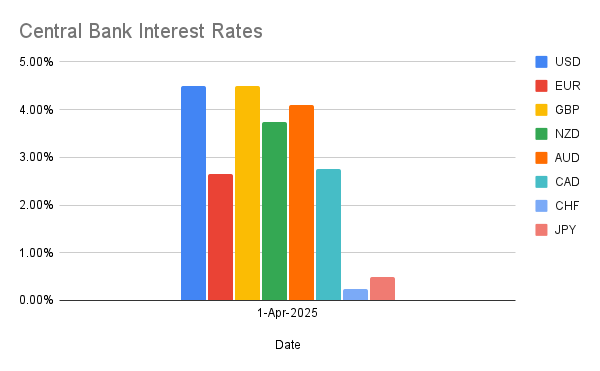April 16, 2025 – Takezo Trading Commentary
The Bank of Canada (BoC) just dropped its latest monetary policy decision, and while the policy rate held steady at 2.75%, the real story isn’t in the number—it’s in the narrative. And this time, that narrative isn’t just domestic. It’s international, political, and riddled with uncertainty.
Let’s unpack what’s changed, what hasn’t, and what this means for traders and macro strategists alike.
What Stayed the Same: The Rate Hold
First and foremost, the BoC decided to keep its benchmark interest rate unchanged at 2.75%, with the Bank Rate at 3% and the deposit rate at 2.70%. This mirrors the position taken in March 2025, where policymakers were already adopting a cautious tone amid slowing growth and volatile inflation.
The key phrase from today’s release: “Governing Council will proceed carefully.” That mantra hasn’t changed. But the forces shaping their caution have.
What’s New Since March: Enter the Tariff Wild Card
The BoC’s March report focused heavily on balancing inflation control with supporting economic growth in a fragile post-COVID recovery environment. Fast forward to April, and the conversation has shifted sharply due to one word: Tariffs.
The United States, Canada’s largest trading partner, has thrown a wrench into the machinery with a sudden and aggressive shift in trade policy. New tariffs, looming threats of escalation, and general unpredictability have darkened the outlook for both growth and inflation—not just for Canada, but globally.
The BoC’s April Monetary Policy Report (MPR) doesn’t offer a single forecast. Instead, it presents two possible trade-policy scenarios:
- Scenario 1: High uncertainty, but limited tariffs. In this case, Canadian growth weakens temporarily, inflation hovers around the 2% target, and things limp along.
- Scenario 2: A prolonged trade war pushes Canada into recession, with inflation jumping temporarily above 3% in 2026 due to supply chain stress and rising costs.
To quote the BoC: “There is also an unusual degree of uncertainty about the economic outcomes within any scenario.”
Translation: they’re not guessing—they’re preparing for everything.
The Global Context

In the broader global picture, economic momentum that looked solid at the end of 2024 is now facing headwinds. Here’s the current read:
- U.S. economy: Slowing down. Inflation expectations are climbing while business sentiment is tanking.
- Eurozone: Still stuck in low gear, especially in manufacturing.
- China: Came in hot last year, but the pace has cooled in early 2025.
- Oil Prices: Down significantly since January, reflecting weaker global growth prospects.
Meanwhile, financial markets are being whipsawed by the back-and-forth on trade threats and delays. Volatility is the name of the game, and that’s weighing on confidence and investment globally.
Domestic Impact: The Drag on Growth
Closer to home, Canada isn’t faring well in the face of rising global tension.
- Consumer and business confidence are slipping due to tariff uncertainty.
- Residential investment, consumption, and business spending all appear to have weakened in Q1.
- Employment declined in March, and wage growth is now showing signs of moderation.
The BoC noted that the labour market recovery is stalling, and firms are pulling back on hiring. This isn’t just a slowdown—it’s a recalibration of expectations.
Inflation: A Tale of Two Forces
Inflation hit 2.3% in March, down from February but still higher than the 1.8% posted in January. A few key forces are at play:
- End of the GST/HST suspension nudged prices up.
- Removal of the carbon tax (starting April) will pull CPI down temporarily for a year.
- Lower oil prices will also exert downward pressure.
- But supply chain disruptions and tariffs are expected to push prices up again.
Short-term inflation expectations are rising as businesses and consumers brace for higher costs. However, long-term expectations remain anchored—at least for now.
BoC’s Balancing Act
In its conclusion, the Bank made it clear: monetary policy can’t solve trade wars, but it can protect price stability.
Their job now is to walk a tightrope:
- Ease the drag on growth where possible.
- Prevent inflation from running wild.
- Navigate a geopolitical landscape that’s shifting beneath their feet.
Strategic Takeaways for Traders
If you’re following my Takezo Trading philosophy—melding economic fundamentals with timeless strategy—the Bank’s latest stance offers a few lessons:
- Expect volatility. Rate holds may seem like “no action,” but the forces underneath are anything but stable.
- Watch the USD/CAD closely. The loonie has been appreciating due to USD weakness, but any fresh escalation in tariffs could reverse that trend fast.
- Inflation is sticky and deceptive. Even with falling oil, embedded costs from trade shocks can skew expectations. Watch the bond markets for clues.
- Scenario planning > forecasting. The BoC is right: this isn’t a time for pinpoint predictions. It’s a time for adaptive thinking.
Final Word
The April BoC decision is less about interest rates and more about the macro environment we’re heading into. We’re moving into a summer of economic chess—not checkers.
Whether you’re a Samurai-tier macro thinker or just getting your Ronin footing, now’s the time to refine your framework. The battlefield of 2025 is shaping up to be dominated not by central banks, but by geopolitics.
Stay sharp, stay nimble—and as always, stay strategic.
– Takezo
https://www.bankofcanada.ca/2025/04/fad-press-release-2025-04-16